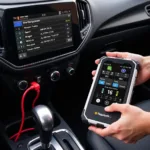Tools for drawing cars have evolved significantly, from traditional pencils and paper to sophisticated digital software. Whether you’re a professional automotive designer, a budding artist, or simply enjoy sketching cars as a hobby, understanding the right tools can dramatically improve your results. This guide explores the various tools available, helping you choose the best fit for your needs and skill level.
From Pencil to Pixel: Exploring Traditional and Digital Tools
Choosing the right tools depends heavily on your desired outcome and personal preference. Traditional tools offer a tactile experience and are excellent for developing fundamental drawing skills. Digital tools, on the other hand, provide flexibility, advanced features, and the ability to easily correct mistakes. Let’s delve into both.
Traditional Tools for Car Drawing
- Pencils: A range of pencils, from hard (H) to soft (B), allows you to create varying line weights and shading effects. Harder pencils are ideal for light sketching and precise lines, while softer pencils are better for darker lines, shading, and creating depth.
- Paper: Smooth, thick paper is recommended for car drawings. Thinner paper can tear easily, especially when using erasers frequently. Consider using a sketchbook dedicated to car drawings.
- Erasers: A kneaded eraser is a versatile tool for lifting graphite without damaging the paper. A vinyl eraser is helpful for removing stubborn marks.
- Rulers and French Curves: These tools aid in creating straight lines and smooth curves, essential for capturing the precise proportions and contours of a car.
- Markers and Colored Pencils: These tools add color and detail to your drawings, bringing your automotive creations to life. Experiment with different colors and techniques to achieve various effects.
After the initial sketch with a hard pencil, use softer pencils to add depth and details. Don’t be afraid to experiment with different techniques!
Digital Tools for Car Drawing
- Software: Software like Adobe Photoshop, Autodesk Sketchbook, and Procreate offer powerful tools for creating stunning digital car illustrations. These programs provide a wide range of brushes, layers, and effects to enhance your artwork.
- Graphics Tablets: A graphics tablet provides a more natural drawing experience compared to a mouse. Pressure sensitivity allows for varying line thickness and opacity, mimicking the feel of traditional pencils.
- Stylus: A stylus is the pen-like tool used with a graphics tablet. Different styluses offer varying levels of pressure sensitivity and features, impacting the precision and control you have over your digital strokes.
- Digital Drawing Displays: These displays allow you to draw directly on the screen, offering a more intuitive and immersive drawing experience. They provide immediate visual feedback, making the transition from traditional to digital smoother.
Learning digital tools requires practice, but the results can be impressive. Explore different brushes and software features to find what works best for your style.
Mastering the Art of Automotive Illustration: Tips and Techniques
Whether you’re using tools to draw cars traditionally or digitally, understanding perspective, proportions, and light and shadow are crucial for creating realistic and dynamic car drawings. Practice drawing basic shapes and gradually progress to more complex forms. Observing real cars and studying their design elements will further enhance your understanding and skills.
Choosing the Right Tools: Factors to Consider
Consider your budget, skill level, and desired outcome when selecting tools. Car parts stamping tools might not be directly related to drawing, but understanding the manufacturing process can inform your design choices. For beginners, starting with basic pencils and paper is recommended. As your skills develop, you can explore more advanced tools and software.
Conclusion: Equipping Yourself for Automotive Art
Selecting the appropriate tools for drawing cars is a pivotal step in bringing your automotive visions to life. From traditional pencils and paper to cutting-edge digital software and hardware, the options are vast. By understanding the strengths of each tool and considering your individual needs, you can embark on a fulfilling journey of automotive artistic expression. Whether you’re aiming for photorealistic renderings or expressive sketches, the right tools combined with practice will empower you to create captivating car drawings. Kids play tools car can even inspire younger artists! Remember, the key is to explore, experiment, and enjoy the process.
FAQ
-
What are the best pencils for sketching cars?
A combination of H and B pencils is ideal for various line weights and shading. -
Is digital drawing easier than traditional drawing?
Both have their own learning curves. Digital offers more flexibility for corrections, while traditional provides a tactile experience. -
What software is recommended for beginners in digital car drawing?
Autodesk Sketchbook is a user-friendly option for beginners. -
What are the essential tools for traditional car drawing?
Pencils, paper, erasers, rulers, and French curves are essential. -
How can I improve my car drawing skills?
Practice regularly, observe real cars, and study automotive design principles. -
What is the advantage of using a graphics tablet?
It offers a more natural drawing experience with pressure sensitivity. -
Where can I find tutorials for car drawing?
Online platforms like YouTube offer numerous tutorials for various skill levels.
Need More Help?
For further assistance with car diagnostics, explore our resources on lighting systems in cars diagnostic. You might also find our article on car tools coloring page helpful.
Contact us via WhatsApp: +1(641)206-8880, Email: [email protected], or visit us at 910 Cedar Lane, Chicago, IL 60605, USA. Our 24/7 customer support team is ready to assist you.


